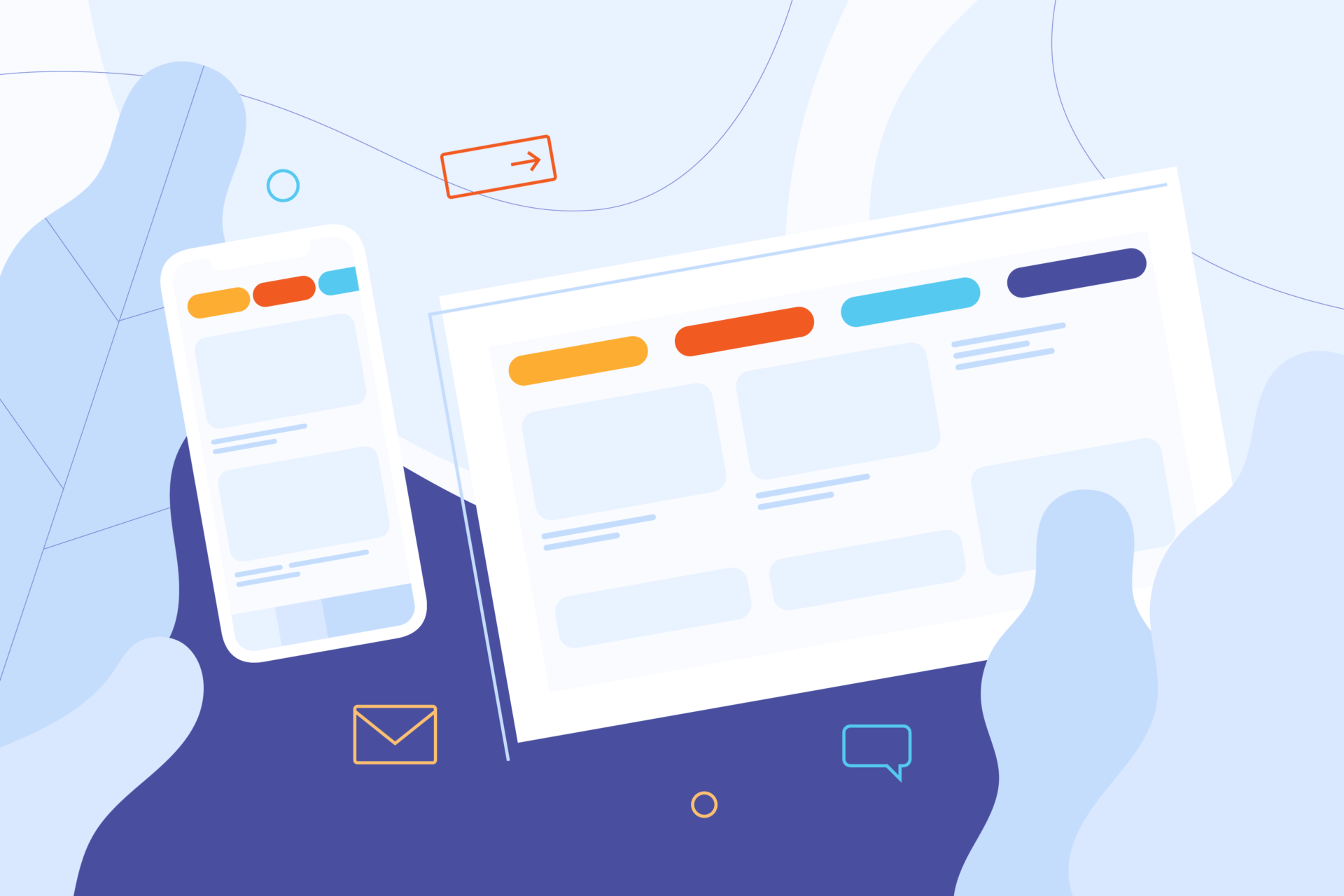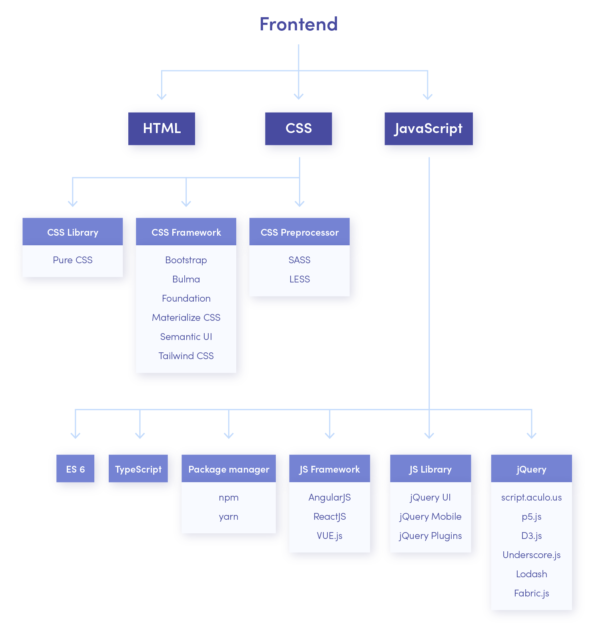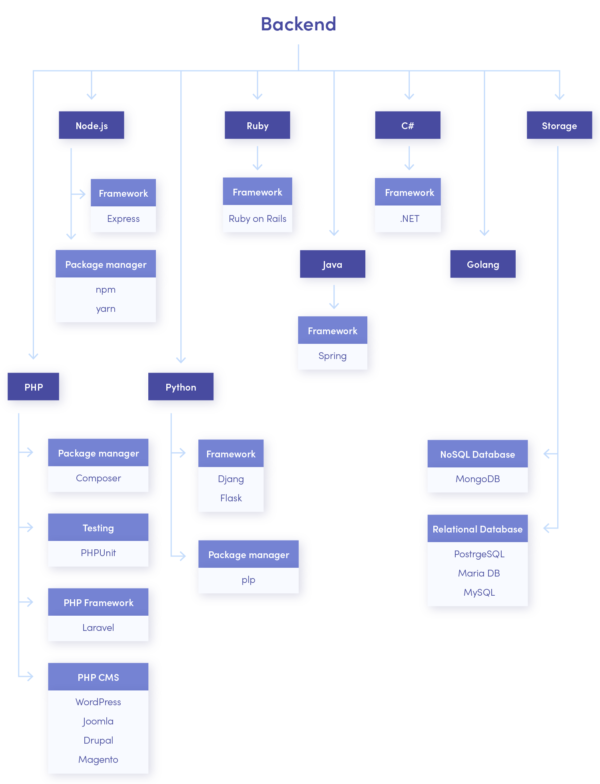If you’re unsure where to start with your software project – this is the post for you. It will guide you through the good, the bad, and the ugly of the getting-started essentials, such as choosing your software development company, aligning core features with your business goals, getting through the development process, and, finally, releasing your product to the market.
Starting your first software development project might be pretty daunting. You’ve begun with this glorious business idea, but now that you’ve taken the next step you’ve come to realise that there are just too many factors at play. There are lots of technologies to choose from. All sorts of different vendors promise you the best price-quality ratio, yet none of them wants to tell you what an estimate price will actually be. And all in the meanwhile, your competitors are plotting their very own big break.
At this point, it’s normal to feel lost, confused, and, possibly, a little bit in over your head.
Well, you’ve come to the right place to get all of those answers. It’s time to learn how software development and business intersect!
Here’s what to expect from this article
For your convenience, each topic of this guide builds up on the previous one, creating a comprehensive yet brief overview of the most important elements of the software development process and technology. Step by step, we’ll deal with the questions like:
- What is an MVP?
- Why is it so difficult to learn the average price for a project?
- Do you need a mobile app or a website?
- What benefits can a good software bring to a specific industry?
- How do web and mobile development differ and what are their programming languages?
- What a development process can look like?
- And how to choose the right software development company for you?
- The first version of your app released to the market is likely to change. A lot. And that’s perfectly normal, after all it’s called a Minimum Viable Product, not Maximum.
- There’s no fixed price for a software solution – most companies work on a time&materials basis and calculate the cost of a project based on man-hours (learn more about time and material vs fixed-price contracts).
- There are different criteria of success and various technology standards depending on the industry your business operates in – work with the company that understands them.
- Web development is about websites, mobile development is about applications. If you need both you’ll have to pay for both (or rely on the early version of Flutter 2.0).
- Frontend is everything a user sees and interacts with on a website. Backend is how the server processes data.
- Native apps are built for a specific platform. In order for your application to function well on both iOS and Android, it needs to be developed cross-platform.
- Web applications are not websites, nor are they “mobile applications”. Instead, they can offer you the best of both worlds.
- People spend more time on their mobile devices than desktop laptops and computers.
- The software development process starts with getting to know your idea and ends with post-release management of your product. Although you are free to change the development company at any stage.
- A good software development company will advise you on the right design and business strategy as well as write flawless code for your project. Don’t settle for anything less.
* * *
Part I: Software development 101
Having an idea for a mobile app or a website is a huge step in the right direction, but as you might have realised by now, it raises more questions than answers. Not to mention that software developers might be a tough crowd. So before you let specific jargon, elusive answers to straightforward questions, or the oversaturated market discourage you, let me tell you this:
You’ve got this.
And we’re here to help you as much as we can. Step by step, through every possible issue you could’ve already encountered or might detect later on as you’re working on turning your vision into reality.
So let’s start simple:
What is an MVP?
I know you’ve seen this abbreviation a lot. Every well-respected software agency throws it at you along with the promise to complete it in 3 months or so. Perhaps, you’ve even Googled it and learnt that MVP stands for a Minimum Viable Product. Now what?
In brief, a Minimum Viable Product is an early version of your digital product that can already be released to the market but will need revisions and improvement later on.
But don’t mistake it for a prototype – prototypes never get to see the end-users outside of the testing and quality assurance iterations. MVPs, however, are right there in app stores earning you some exposure, organic traffic, and first conversions.
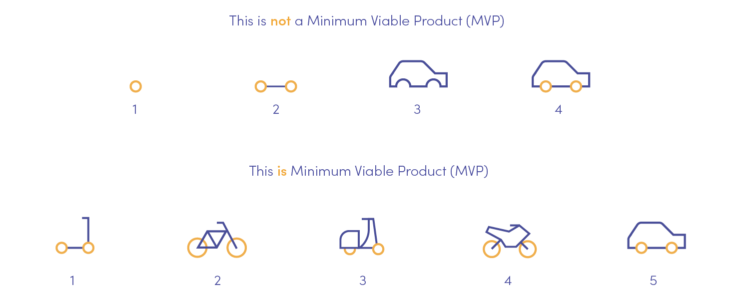
But why on Earth would you release a solution that you know is not perfected to the gorgeous game-changer you know it has the potential to be?
This way you get to save yourself some money and a lot of headaches.
By releasing an MVP, you get to invest in the core features of your product and share it with your target audience to see what they really think about it. This way, you’ll be able to include exactly what is in demand on the market right now, instead of playing a guessing game. And don’t worry – there’s always room for scaling later!
Curious about app scalability? Then this post is for you!
Now that you have a basic understanding of why everyone’s trying to push an MVP on you, let’s talk business: time & money in software development, to be precise.
How much it costs to develop a mobile app
Every project is special. And you can’t put a price on special.
Well, you can, but not right away.
Most software companies, including Miquido, work on a time & materials basis.
It’s an effective flexible model that estimates the overall cost of your project based on the number of team members involved and the time needed to complete your product. Fair and square.
You might have noticed we offer to deliver you an estimated cost of your project in under 48 hours. That means that we still can sit down and evaluate the complexity of your idea and translate it into man-hours. Moreover, we are more than happy to do just that, as long as you can provide a detailed overview of your expectations.
But, unfortunately, we are not able to do that in a way that would summarise and narrow down all the possible results into one effective “average project cost”. And neither are other vendors that choose to work outside of the fixed pricing model.
Learn more about how much does it cost to develop an app
Now, let’s move on to another frequently asked question:
How long does it take to develop an app?
The good news is that here software development companies can get a tad more specific. On average, it takes companies between 3 and 9 months to bring your product to a ready-to-market condition.
There is a variety of factors contributing to the final price of your project:
- its original condition
- the complexity of the technology used
- the number of the specific features you’d like to have included
So, why does it take so long? Mainly, because bringing a digital product to life goes beyond preparing a neatly packaged code. And that is worth the wait.
When your MVP hits the market, it means it’s been verified, designed, programmed, and tested to the best of your team’s ability!
Now let’s take a look at the specifics.
* * *
Part II: Business advantages of powerful software
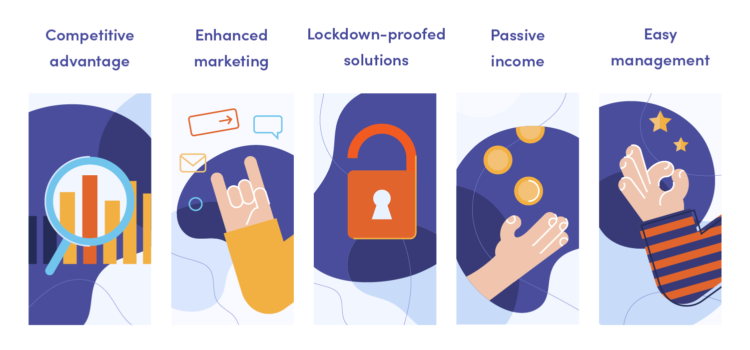
We’ve covered the basics of software development and you could have noticed that it’s a little more complex than you might have originally expected. There are no clear deadlines, estimated price ranges, or any certainty as to what people you will be working with. All those things are established later on after you have committed to the idea of going through with your project.
So, before you make that important decision, I encourage you to take a hard look at your concept once again and to weigh the pros and cons of investing in your solution. To make the process a little bit easier for you, here are some of the strongest reasons to proceed with your project:
- There are 4.28 billion of unique internet users and more than 8.74 billion smart devices. Having a savvy app or a powerful website is the best way to reach those people
- Investing in a digital product is a sure way to enhance your marketing strategy and gain organic traffic
- More and more businesses of all sizes are investing in a website or an application. That gives them an indisputable competitive advantage over those that choose to stay offline
- Digital products and services are on the rise in the post-pandemic era. They are protected against lockdowns and provide an important sense of connectedness, entertainment, normality, etc.
- Developing an app may turn into an effective side hassle, provide a secure source of passive income, or help you advertise your existing product to a brand new audience
- Maintaining a digital product is way easier than managing a full-scale offline business!
Mobile apps have proven to be particularly popular these days, leaving desktop websites far behind. If you’re interested in how a mobile app can specifically benefit your business, make sure to check out this article or, better yet, download our latest report on the future of mobile app development.
Of course, the scope and purpose of your software solution will differ depending on the industry you operate in and the size of your business. During the 10 years of our experience, we’ve worked with companies from various backgrounds, so we know how important some of the distinctions are.
Industry-specific software development
If you checked our website, you might’ve noticed that we aren’t shy to work with all sorts of industries – be it a familiar e-Commerce or a sensible Healthcare. Many software companies do. However, one sure way to spot an impostor is to ask them about being familiar with specific regulations and industry benchmarks.
Knowing your industry can significantly affect the entire product development strategy, not to mention design standards and specific product features or technologies used.
Here’s a quick example. Below, you will find a list of the must-have product features most software vendors will try to convince you to invest in. They are popular with many of their clients and they do, in fact, improve user experience by a lot. At the same time, the same feature that has proven to be absolutely essential for one industry might become completely unnecessary in another.
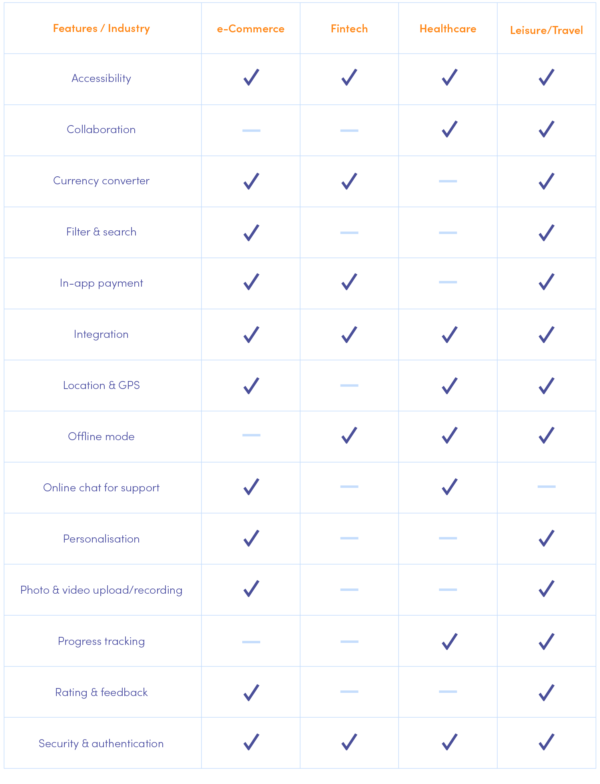
Now, there are a couple of conclusions you could’ve drawn.
For one, you might have recognised that only three features are equally valuable across all the industries: security, integration, and accessibility.
Security goes without saying. Yet, I guess you’ll agree that keeping your password to a bank account or medical records safe is more important than setting up two-factor authentication to your Uber Eats profile.
“Integration” is a pretty vague term that could mean different things for different industries: simply sharing your progress on social media would be considered an integration, but so would the connectivity between two different bank accounts in one app.
It’s all relative.
More importantly, this table demonstrates that not everyone needs everything.
Just like selecting the crucial features for your industry and your product might do all the difference in the world, so can choosing the wrong technology. So let’s make sure you understand every option you have to choose from!
* * *
Part III: Different types of software development services
And so you’ve reached the most complicated, and yet the most important part of the article: what kind of software development services are there for you to choose from?
Let’s say you want an app. But what kind of an app specifically? Do you want it to be accessible only from a specific operating system, like iOS, or would you prefer it to run equally well on iOS, Android, as well as desktop computers? More importantly, are you absolutely positive that an app is a right direction for you to follow? Or, perhaps, a website would be better?
This part of the article should help you get answers to all these questions and more.
And if you’re not sure if you need to start with your project from scratch or if your legacy software modernisation just needs a little tweaking, these two articles should be helpful:
And now it’s time to learn more about different types of development, programming languages, and types of software you can work with.
Generally, there are 2 broad kinds of development: web and mobile. Each has its own specifics, requires separately trained professionals, and may vary dramatically when it comes to the budget. Let’s get to know the two a little bit better.
Web development
Web development is a broad term that covers many different layers of services and technologies needed to complete a fully functioning website. Just so we’re clear, a mobile version of your website still falls under the category of web development.
Web development processes include:
- Web design
- Content creation
- Network security configuration
- Search engine optimisation (SEO)
- Database technology
- Client-side or server-side coding…
… and many others.
There are many ways to go about it, but most people separate web development services into two function-specific categories: frontend and backend.
Frontend is the client side of the website responsible for what the users will be interacting with directly (e.g. page layout, interactivity, visuals, etc.)
The most popular languages used for frontend development are HTML, CSS, and JavaScript (JS). However, it tends to get really complicated really fast if you start digging deeper:
While HTML, CSS, and JS are pretty much the ABC of web development, specific frameworks are becoming more and more popular lately. In Layman’s terms, a framework makes the development process faster and easier because it comes with pre-made components specific to a given language. Make sure you check the article about the best frontend frameworks for more info.
However, to spare you some time, the most trending two are ReactJS (running on JavaScript) and Angular (powered by TypeScript).
Ready to hire frontend developers? Check out our custom frontend solutions!
Backend is the server-side of the website that remains invisible to the user but is crucial for the website’s proper functioning (e.g. it is responsible for data collection and storage processes).
Similarly to frontend, backend development also relies on the array of programming languages and frameworks:
The up and coming ones today are Google’s Golang and NodeJS, yet many developers prefer to stick faithfully to Java (don’t mistake it for JavaScript) instead. Each has its pros and cons, so it is really up to your project goals and your development team’s skill which one to choose.
But to make things a little bit easier for you, here’s how the three compare to each other:
| Java | Node JS | Golang |
|---|---|---|
| Android applications | Cross-platform solutions | Processor-intensive operations |
| Cross-platform development | Increased in-team cooperation | Faster server response |
| Wide range of libraries | Apps aiming for future scalability | Efficient data processing |
| Complex projects | Projects with lower budgets | Simple development & management |
And if you want to read about their differences in more detail, make sure to check out these comparisons:
With that, you should have a pretty good understanding of what web development is and which functions a given language should be best for. Now it’s time to set the score straight with mobile.
Our backend development services include numerous tailor-made solutions. Learn more about them!
Mobile development
Of course, websites are great and all, however, mobile apps hold the real power these days. And there is a lot going on with the applications as well. To begin with, there are many different types of apps. Here is how the situation looks at the moment:
I know, it’s a big hot mess. The good news is that not all of those types of apps really matter anymore. Nowadays, we mainly focus on the following few:
- Native mobile
- Cross-platform
- Single-page web apps
Just like in the case of websites, mobile application development services rely on a variety of programming languages and specific frameworks. We’ll be using them to cover the main differences among the three in the most efficient way possible.
Native solutions are pretty self-explanatory.
These are the applications that can only run on one specific platform (e.g. iOS or Android) at a time.
If you have studied your audience well and can say with absolute certainty that they are much more prone to using one particular operating system over another – go with native.
Learn more about how to choose iOS vs Android app for your project
Native applications are designed and coded with the specific functionality and capability of a given platform in mind, so you can rest assured that they will look and feel great. However, if you decide to go after a new category of users that might favour another operating system you’d have to design, code, and develop the entire thing from scratch.
As a rule, that’s a costly process that extends your time-to-market for another developmental cycle. That’s why, if you suspect there’s a chance your audience might use both iOS and Android platforms, we usually recommend going with cross-platform app development.
As you might have guessed, cross-platform solutions are those that function and look equally well on different operating systems while also using the same code.
Cross-platform apps look and work equally well on different platforms (e.g. iOS and Android)
There are numerous advantages of cross-platform development. The most popular ones include:
- Broader audience reach
- Lower development costs
- Faster release
- Simplified maintenance
And when it comes to cross-platform app development, there are two dominating frameworks: React Native (don’t mistake it for React JS!) and Flutter. The two are far less similar than the backend frameworks we’ve covered in the previous section, which is why it is really important for you to understand the difference between the two as well as the main advantages of each:
| React Native | Flutter |
|---|---|
| Community support | Single-base code |
| More developers available | Accent on User Interface |
| Great for certain specific features | Less likely compatibility issues |
| Well-established player on the market | Fast development AND performance |
As one of the first companies to ever adopt Flutter app development, we couldn’t recommend it enough. However, many business owners and developers still choose React Native because it’s been around for a while and has a good reputation as a powerful cross-platform framework.
Yet, it doesn’t mean that Flutter doesn’t already have a large portfolio of successful software development projects of its own! As Google is the company behind this rapidly developing framework, it’s no wonder it’s being used in some of their most trending solutions, like Google Ads or Google Assistant. And if you’re looking for some projects outside of the big G, make sure to check these top Flutter apps.
Moreover, with its latest update, Flutter allows you to go beyond iOS and Android by adding web applications to the mix of its cross-platform magic. This means that after some polishing, the developers will be able to write a single code for an app that would look and feel equally good on iOS, Android, and your laptop! This takes us to the final part of our discussion about the different types of applications.
Just like creating a mobile version of a website is still qualified as web development, launching an application that will only be accessible from a desktop or a browser is considered to be mobile app development.
Unlike your typical mobile app, a web application doesn’t need to be downloaded, thus saving a lot of precious storage space. And unlike most websites, they tend to get highly functional and interactive. And there are lots of other perks that different types of web apps have to offer.
For example, Single Page Applications (SPAs) run without page reloads, creating a smooth user experience.
Still a little fuzzy on the difference between UX and UI? This post will help!
On the other hand, there are Progressive Web Apps (PWAs) that mimic mobile apps’ functionality so well they have learnt to run offline while being accessed through web browsers.
And with that, you should know the most important stuff about different web and mobile development services as well as the specific languages and technologies used for them.
The next big question is how to develop a successful software development project, and that’s what the next part is going to be all about.
* * *
Part IV: How the development process looks like
This is a broad topic that could cover an entire book of its own. Depending on the level of your familiarity with the specifics of IT as an industry, your business requirements and goals, the condition of your project, the consistency of your software development team, as well as numerous other factors, there are different pitfalls that could be waiting for you as you’re trying to navigate through the development. And we’re here to help you address the most important issues.
Let’s begin by defining the specific stages of the mobile app development process and what would be expected of you throughout each of them.
The 5 stages of app development: The Miquido Way

Every vendor is likely to have their own approach to your project development process, some offering a more specific one than others. However, the roadmap is usually very similar. Here, we will explain how we like to do things at Miquido, but it should provide you with a pretty good general idea of what to expect from whichever software development company you choose.
First of all, let me tell you that there is usually a possibility to complete your project on-site or remotely. Of course, with the spread of the pandemic, remote software development has grown to be more and more popular. The decision is always yours to make, however. Regardless of whether you choose to be personally present at your vendor’s office or if you decide to participate in the meetings online, the general process of application development follows similar 5 stages:
We begin by asking a lot of questions: about your industry, your business goals, product expectations. We are about to establish a fruitful partnership together, so getting to know each other and the scope of work is essential.
At this stage, we also validate your product idea in order to map out the potential features, technologies, and development schedule.
Oftentimes, the previous stage reveals certain gaps in a business strategy from the perspective of the available technologies. Say, you wanted to invest in a Swift solution, but we have insightful evidence that your target audience responds equally well to Android apps. It’s our job to tell you that cross-platform would be a better choice here.
Software companies organise all sorts of workshops and product bootcamps in order to ensure that your final product becomes a success. And after the strategising is done, we also complete the basic app wireframes, development requirements, etc.
Contrary to popular opinion, product design and development are just the tip of the iceberg that’s done in the middle of the entire project. As you already know, the industry benchmark for releasing a functional MVP is 3 months, so that’s how long the third stage usually takes.
This is when the magic happens. Here, we get to tackle the most crucial challenges, such as app accessibility, user retention, app security and standardisation, as well as other numerous technological attributes. But in the end, you get a product ready to see the world!
Once your app is ready to hit the market, a good vendor would make sure it does so in the best way possible. At Miquido, we personally take care of the deployment and release of your application.
Finally, since an MVP is only the first iteration of your grand idea, ongoing maintenance allows software development companies to help you implement new features, test your solution, or scale it in the future.
Need help with app store optimisation or website SEO checkup? A really good software retailer would be able to help you with that as well with numerous post-release updates, changes, and issues that might pop up!
To learn more about the importance of app store optimisation and some of the best practices for a specific platform make sure to check these detailed instructions:
Now, it’s good that you have an overall understanding of how the development process looks like. But it sure isn’t enough for you to be ready. As we all know, the devil is in the details. So let’s talk about the people you’re about to spend the next three months with.
Developers teams’ composition
Let’s begin by defining how many people will be eager to meet you as soon as you sign the deal. Long story short – it depends.
Here’s a phrase you haven’t heard in a while: every project is unique. So, obviously, a team composition for each project will be unique as well. But, generally, there should be at least 4 people to help you navigate throughout your project development:
- A project manager – your point of contact, your bridge, your rock. PMs are responsible for explaining what the developers can do and translating what you expect of them to the agile processes.
- A designer – someone, who understands how your target audience thinks and what they really want. But also, someone who is talented enough to translate it into an effective intuitive application design.
- A software developer – a person, who would sit down and translate your vision into a functional app. The general rule is at least one developer per one technology. So if your project uses a couple of technologies it will automatically require more developers.
- A quality assurance specialist, a.k.a. Tester – a pro in spotting even the tiniest mistake in the finalised version of your product. Because, as well all know, people love searching for mistakes. So it’s better to have someone to do that, instead of hoping none of the end-users spots a bug.
That said, it’s time for the final part of our brief introduction to software development. Perhaps, the most important one. Because the time has come to answer the Big Question.
* * *
Part V: How to choose the best software provider
You might think it’s easy. You might think that it’s enough to type “the best software development company” in your search engine and go after the first five results. If you tried that approach, you probably know that said first page usually includes promos, paid listicles, and an occasional software house with a really good SEO. Don’t get me wrong, there’s nothing wrong with good SEO, but how should it be helping you understand who really is the best?
A more careful approach would be searching for your next vendor on a specific platform, such as Clutch. However, it is still far from perfect. After all, there are lots and lots of software development companies with great ratings in your area. So how can you be sure that that one would be just right for you and your business?
Don’t stray from the details – search for them!
For that, we encourage carrying out some in-depth research. Trust me, it will pay off in the end! Here are some signs that you’ve come to the right place:
- A portfolio of the projects they’ve completed has companies and solutions similar to yours. If you’re a multinational corporation looking to automate your operations, a software house that has only worked with small e-Commerce businesses might not be the best decision.
- They offer the technology you’re interested in. For example, at Miquido, we don’t work with VueJS, choosing Golang instead for our projects. So, if it is really important for you to incorporate a specific technology, double-check your software company’s tech stack.
- You are located in similar timezones. This may not seem like a big deal, but there’s a reason why nearshore software outsourcing is growing more and more popular with businesses of all shapes and sizes.
It should be a clear benefit if the company offers a holistic approach. The best way to make sure your project will succeed is to work with a vendor who can not only write an effective code but is also able to advise you on the best business strategies to market your solution later on.
Keep an eye on the specifics and don’t judge the book by its cover. The agencies with the coolest websites may turn out to be unreliable vendors and vice versa.
At the end of the day, it’s much better to spend some more time on selecting the right software development partner before the project starts than coming to realise you’ve made a mistake once it’s halfway completed.
* * *
Congratulations! You’re all covered!
By now, you should have a pretty good understanding of how software development life cycle works, how it can bring additional value to your business, how to find the right company to partner up with, and even how the development process itself is organised. Of course, it is all good in theory and there will be many more questions once you’ve moved on to practice. But let me assure you:
With the right team backing you and your idea up, there’s nothing that could get in your way to success!
If you’re looking for such an offshore software development company right now – see what we have to offer. Who knows, perhaps soon we’ll be working on your project together and laughing about how scary it all seemed in the beginning.

